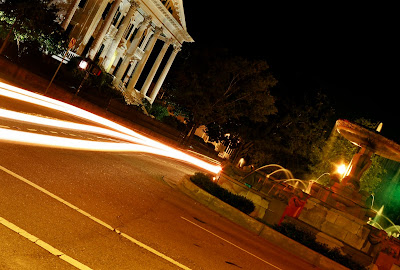Equipment
There are a few key pieces of equipment needed for successful light trails. One question I have been asked a lot is: can you take light trail photos with a digital point and shoot? Maybe. It all depends on whether or not your point and shoot has the ability to manually control exposure to any setting. Most point and shoots do not allow this level of control, however.
An SLR or DSLR is really needed to get these photos done successfully. The best film to use is Fuji Reala 100ASA, or if using a DSLR set the ISO setting to 100.
You will, of course, need a tripod. A sturdy one at that. With the long exposure times, you will need to make sure the camera does not move at all.
A shutter release cable or remote is another essential item. Most shutter release cables have locking features that will allow you to lock the shutter open, then press the button again to release.
Location, Location, Location
When scouting locations there is one critical element to keep in mind: light. Usually you would want an abundance of light when taking night photos, but this is different. Here, you want as little light as possible.
The most striking light trail photos are ones where the only light comes from the vehicles. So, finding a dark area to take the photos is better than, say, along a downtown city street surrounded by street lamps.
The photo below was a light trail photo I took near downtown Wilmington, North Carolina. I learned a very important lesson that night about locations: watch out for traffic lights. First of all, the bright green and red from the traffic lights was drowning out the action of the shot. Secondly, this particular intersection was on a 30-second switch regardless of traffic. 30 seconds was just about not enough time to allow enough vehicles to pass through to make the shots interesting.
Also, try to find a location that might have one bright object to anchor the photo with. The water fountain in the photo below was a good anchor point. I was surprised at how clear it and the house opposite the fountain turned out.
Timing
Just because this needs to be a night photography shot does not mean it should be done at 2AM. I took my photos at about 11PM, and that was almost too late. Timing is key because of the amount of traffic.
First of all, a great time to get some interesting light trail photos is just after sunset. The sky is just darkening, headlights are on, and there will usually still be a good amount of traffic out and about.
Another good time to go is around 2AM on the weekends. I live in a city with a fairly busy downtown area for night clubs and bars, all of which close at 2AM. Hundreds of vehicles, mostly taxis, start to pour out of downtown between 2-3AM on Friday and Saturday nights.
Technique
Alright, now it's time to actually give it a go. Some additional equipment I would suggest that I did not list above is a flashlight, a chair, and a blanket or jacket. I took the photo below in June, so it was still 85 degrees at midnight.
After setting up the camera and tripod equipment, find your location and hunker down. Make sure you are comfortable, because you could be there awhile.
Because you are shooting in low light conditions, whether it be 8PM or 2AM, your light meter will probably be useless. So, it is a fair amount of guess work involved with aperture and exposure.
I usually keep an aperture of either 5.6, 6, or 8. I usually try for an exposure of between 8-15 seconds, although using a much longer exposure will not affect the quality of the image. I think you would find it very difficult to over-expose a night shot.
 This photo was taken with a Pentax K1000, Fuji Reala 100ASA, f/5.6, 12 second exposure. I took several other photos that night with exposures up to 30 seconds, all of which turned out rather nice.
This photo was taken with a Pentax K1000, Fuji Reala 100ASA, f/5.6, 12 second exposure. I took several other photos that night with exposures up to 30 seconds, all of which turned out rather nice.Now, it's time for you to get out there and give it a try yourself. Just keep in mind to bracket your shots with exposure times. All that is important is to catch those headlights/taillights!
No comments:
Post a Comment